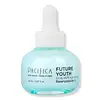What's inside
What's inside
 Key Ingredients
Key Ingredients

 Benefits
Benefits

 Concerns
Concerns

No concerns
 Ingredients Side-by-side
Ingredients Side-by-side

Water
Skin ConditioningAloe Barbadensis Leaf Juice
Skin ConditioningGlycerin
HumectantCaprylic/Capric Triglyceride
MaskingHelianthus Annuus Seed Oil
EmollientAcetyl Hexapeptide-8
HumectantAcetic Acid
BufferingGlyceryl Stearate
EmollientCetyl Alcohol
EmollientLeuconostoc/Radish Root Ferment Filtrate
AntimicrobialPhaseolus Angularis Seed Extract
AntioxidantCitric Acid
BufferingAlbizia Julibrissin Bark Extract
MaskingDarutoside
Skin ConditioningStearic Acid
CleansingPalmitoyl Tripeptide-5
Skin ConditioningTrifluoroacetyl Tripeptide-2
Skin ConditioningAcmella Oleracea Extract
Skin ProtectingCaprooyl Tetrapeptide-3
Skin ProtectingLactobacillus Ferment Lysate
Skin ConditioningFragaria Ananassa Seed Oil
AntioxidantEctoin
Skin ConditioningCaffeine
Skin ConditioningSh-Polypeptide-50
Skin ConditioningPotassium Sorbate
PreservativeXanthan Gum
EmulsifyingTocopherol
AntioxidantGlyceryl Stearate Citrate
EmollientDextran
Leontopodium Alpinum Flower/Leaf Extract
Skin ConditioningSaccharomyces/Xylinum/Black Tea Ferment
Skin ConditioningCamellia Oleifera Seed Oil
Skin ConditioningVanilla Planifolia Fruit Extract
Skin ConditioningSodium Hyaluronate
HumectantEthylhexylglycerin
Skin ConditioningPassiflora Incarnata Flower Extract
Skin ConditioningPhenoxyethanol
PreservativePaeonia Albiflora Root Extract
Skin ConditioningOryza Sativa Extract
AbsorbentSaccharomyces/Malus Pumila Fruit Ferment Filtrate
EmollientCamellia Sinensis Leaf Extract
AntimicrobialPunica Granatum Extract
AstringentWater, Aloe Barbadensis Leaf Juice, Glycerin, Caprylic/Capric Triglyceride, Helianthus Annuus Seed Oil, Acetyl Hexapeptide-8, Acetic Acid, Glyceryl Stearate, Cetyl Alcohol, Leuconostoc/Radish Root Ferment Filtrate, Phaseolus Angularis Seed Extract, Citric Acid, Albizia Julibrissin Bark Extract, Darutoside, Stearic Acid, Palmitoyl Tripeptide-5, Trifluoroacetyl Tripeptide-2, Acmella Oleracea Extract, Caprooyl Tetrapeptide-3, Lactobacillus Ferment Lysate, Fragaria Ananassa Seed Oil, Ectoin, Caffeine, Sh-Polypeptide-50, Potassium Sorbate, Xanthan Gum, Tocopherol, Glyceryl Stearate Citrate, Dextran, Leontopodium Alpinum Flower/Leaf Extract, Saccharomyces/Xylinum/Black Tea Ferment, Camellia Oleifera Seed Oil, Vanilla Planifolia Fruit Extract, Sodium Hyaluronate, Ethylhexylglycerin, Passiflora Incarnata Flower Extract, Phenoxyethanol, Paeonia Albiflora Root Extract, Oryza Sativa Extract, Saccharomyces/Malus Pumila Fruit Ferment Filtrate, Camellia Sinensis Leaf Extract, Punica Granatum Extract
Water
Skin ConditioningPropanediol
SolventHydroxyethyl Urea
HumectantGlycerin
HumectantCollagen
MoisturisingBetaine
HumectantBeta-Glucan
Skin ConditioningPanthenol
Skin ConditioningAloe Barbadensis Leaf Extract
EmollientPortulaca Oleracea Extract
Skin ConditioningSodium Hyaluronate
HumectantEthylhexylglycerin
Skin ConditioningXanthan Gum
EmulsifyingPhenoxyethanol
PreservativeGold
Cosmetic Colorant
 Reviews
Reviews

Ingredients Explained
These ingredients are found in both products.
Ingredients higher up in an ingredient list are typically present in a larger amount.
Ethylhexylglycerin (we can't pronounce this either) is commonly used as a preservative and skin softener. It is derived from glyceryl.
You might see Ethylhexylglycerin often paired with other preservatives such as phenoxyethanol. Ethylhexylglycerin has been found to increase the effectiveness of these other preservatives.
Glycerin is already naturally found in your skin. It helps moisturize and protect your skin.
A study from 2016 found glycerin to be more effective as a humectant than AHAs and hyaluronic acid.
As a humectant, it helps the skin stay hydrated by pulling moisture to your skin. The low molecular weight of glycerin allows it to pull moisture into the deeper layers of your skin.
Hydrated skin improves your skin barrier; Your skin barrier helps protect against irritants and bacteria.
Glycerin has also been found to have antimicrobial and antiviral properties. Due to these properties, glycerin is often used in wound and burn treatments.
In cosmetics, glycerin is usually derived from plants such as soybean or palm. However, it can also be sourced from animals, such as tallow or animal fat.
This ingredient is organic, colorless, odorless, and non-toxic.
Glycerin is the name for this ingredient in American English. British English uses Glycerol/Glycerine.
Learn more about GlycerinPhenoxyethanol is a preservative that has germicide, antimicrobial, and aromatic properties. Studies show that phenoxyethanol can prevent microbial growth. By itself, it has a scent that is similar to that of a rose.
It's often used in formulations along with Caprylyl Glycol to preserve the shelf life of products.
Sodium Hyaluronate is hyaluronic acid's salt form. It is commonly derived from the sodium salt of hyaluronic acid.
Like hyaluronic acid, it is great at holding water and acts as a humectant. This makes it a great skin hydrating ingredient.
Sodium Hyaluronate is naturally occurring in our bodies and is mostly found in eye fluid and joints.
These are some other common types of Hyaluronic Acid:
Learn more about Sodium HyaluronateWater. It's the most common cosmetic ingredient of all. You'll usually see it at the top of ingredient lists, meaning that it makes up the largest part of the product.
So why is it so popular? Water most often acts as a solvent - this means that it helps dissolve other ingredients into the formulation.
You'll also recognize water as that liquid we all need to stay alive. If you see this, drink a glass of water. Stay hydrated!
Learn more about WaterXanthan gum is used as a stabilizer and thickener within cosmetic products. It helps give products a sticky, thick feeling - preventing them from being too runny.
On the technical side of things, xanthan gum is a polysaccharide - a combination consisting of multiple sugar molecules bonded together.
Xanthan gum is a pretty common and great ingredient. It is a natural, non-toxic, non-irritating ingredient that is also commonly used in food products.
Learn more about Xanthan Gum